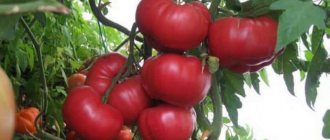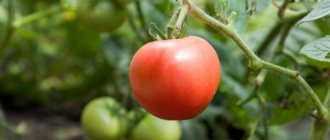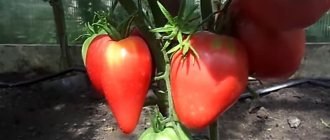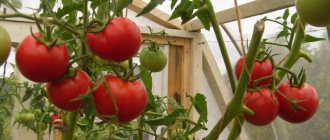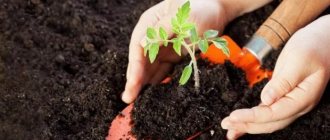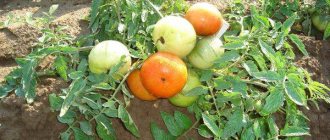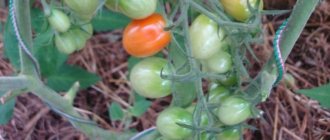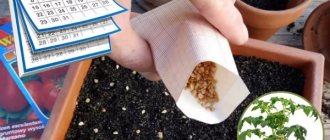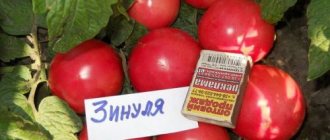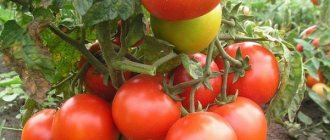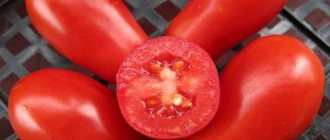Fatalist - variety of Tomato plant
Variety characteristics:
Properties of the Fatalist variety:
Recommended region on the map:
Information on admission of Tomato Fatalist from the Register of the State Variety Commission of the Russian Federation
Application for admission No. 31788, registered 1998-11-20.
The Tomato Fatalist variety was included in the register of approved varieties in 2001. Approved for use in the regions: Central. The originator of the Tomato Fatalist variety is:
Other varieties of tomato plant
Search for variety by name
Variety selection
Question to the portal experts
If you haven't found the answer to a question, don't hesitate to ask an expert.
Have you already planted Tomato Fatalist?
Tell us if you liked this variety? Will you plant it again?
Add new comment
Register or Login so you don't have to enter your Name and Email every time
Thanks for the comment! It will be published after checking by a moderator!
Comments
No comments yet, be the first!
A portal for those who love their dacha
Thanks for your question!
Your question has been sent for moderation. Don't worry, we quickly check your questions and your question will be answered within 1 day.
We have noticed that you are already registered on our website. We recommend that you log in to view the question you created. If you don't remember your password, you can recover it.
You were not registered until today, so we have registered you. Your password has been sent to your specified mailbox.
Help our site develop!
Please read this message, it will not take up much of your time!
We so need your comments and questions to understand in which direction we should develop.
Don't forget to leave a comment if you found what you were looking for. And if you haven’t found it, use the “Ask an Expert” form in the site header. We will answer this question, and other visitors will be able to find the information that you could not find.
Sincerely, team of the portal Dacha-Dacha.ru
Thanks for your question!
Your question has been sent for moderation. Don't worry, we quickly check your questions and your question will be answered within 1 day.
We have noticed that you are already registered on our website. We recommend that you log in to view the question you created. If you don't remember your password, you can recover it.
You were not registered until today, so we have registered you. Your password has been sent to your specified mailbox.
Tomato Tretyakovsky F1
Tomato Tretyakovsky F1 is a tall hybrid that begins to bear fruit 90-105 days after germination. I liked this variety because it produces a lot of fruit. From 1 sq. meter you can harvest up to 16 kg of tomatoes.
This hybrid is also resistant to a number of diseases, especially fusarium, which very often affects tomatoes in the greenhouse. Well, another main quality of this tomato is its taste. Tomatoes are tasty and healthy because they contain a lot of carotene and vitamins.
Most Popular
The tomato varieties Semko-Sinbad, De Barao, and the hybrid Ivanhoe F1 have received well-deserved distribution in amateur and farm farms. In a greenhouse, these varieties can produce a yield of more than 20 kg per bush.
De Barao
De Barao
The most common tomato variety for both greenhouses and open ground is often called golden De Barao. With good care in a greenhouse it yields up to 30 kg per plant, in open ground - 10 kg.
Late-ripening (120 days) indeterminate variety with a height of 2 m or more. Inflorescences are formed from 9-11 leaves. The fruits are medium-sized, ovoid, weighing 60 g. The taste is pleasant. De Barao fruits are good both fresh and for canning whole fruits.
Agrotechnical features: sensitive to soil looseness, fertilizing and microclimate.
Several variations of this variety have been bred: De Barao black, pink, yellow. They are all tasty, beautiful and productive.
Quite old, but still popular early ripening hybrid. Valued for its early maturity - 85-93 days from germination. Determinate plant. The inflorescence contains 8 round, smooth fruits weighing 85-90 g.
The first brush appears above the 6-7 sheet, the rest after 1-2 sheets. The taste is good and excellent. Produces yield well and is disease resistant. The Semko-Sinbad F1 tomato can be planted both in a film greenhouse and in open ground. Productivity – 10 kg per 1 sq. m.
Ivanhoe F1
Ivanhoe F1
Mid-season, indeterminate. The bush is large, with powerful stems and roots. The fruits are flat-round, ribbed, dense, red. Fruit weight is 170-180 g, tomatoes do not decrease from the base of the bush to the top. The taste is good, the fruits are transportable and do not crack.
Alhambra F1
Indeterminate bush, short internodes. The inflorescence is formed above the 9th leaf, the next ones - after 3 leaves. The fruits are round, slightly ribbed, red, weighing up to 170 g. The clusters do not break. The taste is excellent for hybrid fruits.
Resistant to a number of diseases (fusarium, cladosporiosis and tobacco mosaic virus).
Tags: description, variety, tomato, fatalist, characteristics
About the author: admin4ik
« Previous entry
Tomato Westland F1
The Westland tomato is a tall hybrid that begins to bear fruit 90-100 days after the first shoots appear. I paid attention to this hybrid for its high yield. From 1 sq. meter you can harvest 60 kg of tomatoes.
The tomatoes are very tasty and sweet, the fruit weight is 130 g. They are suitable for preparing salads, as well as for winter preparations.
The only negative is that the plant requires care, regular feeding and watering. But this is quite possible to cope with. Therefore, I will definitely plant this hybrid.
Also worth about. This plant grows well and produces an excellent harvest of tasty and fleshy tomatoes. But it was a little difficult for me to grow Oxheart seedlings. She was small, I thought the plant would not have time to grow and produce a harvest. Despite this, I sat down and was surprised. The bushes began to quickly grow green mass and pleased with a good harvest.
And you can find out how to use the resulting harvest on my channel “
Joy of Being” , where I publish for you many exclusive homemade recipes.
conclusions
The yield on these two control bushes was also good, but less than on the experimental ones formed in the manner described above - only 7.3 kg per plant.
1. despite the increased time spent and a slight delay in the onset of fruiting, the formation of multi-stemmed tomatoes in the conditions of summer cottages and household plots may well be used;
2. increasing productivity by 30-40% is economically beneficial, since it does not require any additional costs.
Among the varieties and hybrids, you can select tomatoes with high yield (super yield) and desired properties. Don’t be afraid to experiment with new hybrids (capable of self-pollinating) in your garden, but don’t give up proven varieties either.
In heated greenhouses with an extended growing period, it is more profitable to plant indeterminate hybrids that continuously set fruit. Caring for them includes fertilizing, regular tying and pinching.
High-yielding tomato varieties will show the best results in greenhouse conditions, with good feeding and proper care.
Read about Adam cucumber seeds here.
High yield
Among the tall, indeterminate tomato varieties, there are a number of particularly productive ones. They are grown not only in private farmsteads, but also in industrial greenhouses. Such tomato seeds are available to every gardener. A description of the most famous tall varieties, characterized by particularly high yields, is given below.
Admiro F1
This representative of the Dutch selection is a hybrid. It is grown exclusively in protected conditions. The height of the bushes of this variety exceeds 2 m, so it is necessary to plant plants no thicker than 3-4 pcs/m2. The variety is resistant to TMV, cladosporiosis, fusarium, and verticillium. It can be cultivated in regions with unfavorable climatic conditions. It is characterized by consistently high yields of up to 39 kg/m2. Tomatoes of the Admiro F1 variety are red in color and flat-round in shape. Their flesh is moderately dense and sweet. The weight of each tomato is approximately 130 g. The purpose of the fruit is universal.
De barao royal
Many experienced gardeners know a number of varieties with this name. Thus, there are “De Barao” tomatoes in orange, pink, gold, black, tiger and other colors. All these varieties are represented by tall bushes, however, only “De Barao Tsarsky” has a record yield. The yield of this variety reaches 15 kg per bush or 41 kg per 1 m 2 of soil. The height of an indeterminate plant is up to 3 m. It is recommended to plant no more than 3 such tall bushes per 1 m2 of soil. Each fruiting cluster bears 8-10 tomatoes at a time. For vegetables to ripen, it takes 110-115 days from the day of emergence. Tomatoes of the “De Barao Tsarsky” variety have a soft crimson color and an oval-plum shape. Their weight varies from 100 to 150 g. The taste of the fruit is excellent: the pulp is dense, fleshy, sweet, the skin is tender and thin.
Azarro F1
An excellent hybrid that allows you to get a harvest of up to 36 kg/m2. It is recommended to grow it in protected conditions. Plants are indeterminate and tall. For their cultivation, it is recommended to use the seedling method. The cultivation technology involves placing no more than 3-4 bushes per 1 m 2 of soil. The variety is resistant to most common diseases. It takes 113-120 days for its fruits to ripen. The crop yield is high - up to 36 kg/m2. Tomatoes of the Azarro F1 variety have a flat-round shape and a red color. Their flesh is dense and sweet. The average weight of the fruit is 150 g. A special feature of the hybrid is the increased resistance of tomatoes to cracking.
Brooklyn F1
One of the best hybrids of foreign selection. It is characterized by medium-early fruit ripening (113-118 days) and high yield (35 kg/m2). The culture is thermophilic, so it is recommended to grow it exclusively in greenhouse conditions. It is necessary to plant tall tomatoes with a frequency of 3-4 pcs/m2. Plants are resistant to a number of common diseases and do not require additional treatment during the growing season. Tomatoes of the “Brooklyn F1” variety are presented with a flat-round shape. Their color is red, the flesh is juicy, slightly sour. The average weight of the fruit is 104-120 g. Tomatoes are distinguished by excellent keeping quality and resistance to damage during transportation. You can see the fruits of this variety higher up.
Subtleties of forming multi-stemmed tomatoes
I form tied stems like this. I leave all the flower brushes that appear on the stems up to the trellis (usually 5-6 pieces). Since the plants form three stems, each bush has 15-18 clusters.
But additional stepsons will definitely grow on the bushes. I usually leave 3-4 of them. I clear the stepson from the leaves to the brush, and leave 1-2 leaves above it. I also hang these stepsons either by a trellis (poles) or by a vertically stretched rope, otherwise the shoot may break. Each such brush on the stepson weighs on average 350 g, which gives an increase in yield of approximately 1.5 kg.
Link on topic: Formation of tomatoes - indeterminate and determinate
But I still have three basal stepsons growing up. On them, each cluster produces 500 g of fruit, providing an increase of 1.5 kg. If we add everything up, it turns out that the total yield from the bush is 10 kg.
And with 1 m2 - 30 kg. This result suits me quite well, because the upper yield limit of the Fatalist hybrid is 35 kg/mg. But this figure is achieved in the most favorable conditions, which cannot be said about our northern climate.
Last season, in order to find out the possibilities of fruiting, I did not specifically limit the formation of clusters, and there were 24 of them on one bush, and 25 on the second. The tops of the stems reached a height of 3 m, and I simply put them on poles.
We invite you to familiarize yourself with: Tomato gold medal characteristics and description of the variety
The most productive varieties of tomatoes for the greenhouse
Tomato is a favorite vegetable for most gardeners. It is grown mainly in greenhouses and greenhouses, which allow creating the most favorable microclimate for this heat-loving crop. Breeders offer many varieties of tomato, each of which has a special taste, distinctive shape, fruit color, and various agrotechnical characteristics. At the same time, many farmers pay special attention to tomato yields. Thus, the article presents the most productive varieties of tomatoes for greenhouses, which allow you to get more than 30 kg of fruit from 1 m2 of soil per season. Below is a detailed description of such record-breaking varieties, and the taste and agrotechnical characteristics of their fruits are indicated.
High-yielding varieties
In most cases, indeterminate tomatoes have record high yields, capable of growing and bearing fruit until the onset of unfavorable conditions. For growing such varieties, a greenhouse or greenhouse is an excellent option. In protected conditions, the temperature remains higher than in the open ground; the plants are not afraid of short-term cold snaps and early frosts, which means that the harvest can be harvested until late autumn.
The highest-yielding indeterminate tomatoes for growing in a greenhouse include:
Fatalist f1
A tomato variety widely known to Russian farmers. It is characterized by exceptionally high productivity, which with proper care is about 38-40 kg/m2. The tomato is an indeterminate tomato; its bushes are very tall and leafy. When growing a tomato for the Fatalist f1 greenhouse, you should take care of timely staking and bush formation. This will prevent damage to the plant when exposed to a large number of fruits.
Tomatoes “Fatalist f1” ripen 100-110 days after sowing the seed. Before the onset of technical ripeness, the fruits are colored green; as they ripen, their color becomes bright red. The weight of one vegetable is 120-160 g, the shape of such fruits is flat-round. Tomatoes have tasty, juicy pulp. Their skin is thin and rough. The variety has increased resistance to cracking. The purpose of tomatoes is universal; they can be used in preparing salads and for canning.
Admiro f1
The hybrid is a representative of the Dutch selection. In temperate climates, Admiro f1 tomatoes grow well and form abundant ovaries. It is recommended to grow the variety in greenhouses. Tall indeterminate bushes should be planted no thicker than 3-4 plants per 1 m2 of soil. By timely watering, loosening and fertilizing the plants, it will be possible to obtain a harvest of tasty red tomatoes in an amount of more than 39 kg/m2. Such a high yield allows you to eat fresh tomatoes during the season and prepare pickles for the whole winter.
Refusal of the classical scheme
In the spring of 2015, when the seedlings had grown and acquired 6-7 leaves (about a month after picking), I plucked off the growing points of two Fatalist plants. This was the beginning of the formation of bushes. But I didn’t touch the control seedlings.
By the time of planting, the beginnings of stepsons appeared on the plants, which I did not remove. This turned the tomatoes into multi-stemmed bushes. In this condition - with 5-6 stepsons - I planted two bushes in deep holes on April 20.
I always lay leaves at the bottom in a layer of about 10 cm, this serves as thermal insulation from the cold lower soil. I grew two more Fatalist bushes according to the classical scheme: one main stem and the second from under the first cluster.
When the stepsons on the bushes formed in the new way began to grow, I chose the top three as the main stems, tying them with ropes to the trellis. The roots, along with the three stepsons of each bush, were covered with earth in two steps to ground level, and then even hilled up the plants. This method forces the roots to work at all levels.
After backfilling, the stepsons acquire their own roots and do not take away nutrition from the mother bush, do not oppress it, being, in fact, independent plants. All this is shown in the figure.
When filling holes, I make sure to add humus to the excavated soil in a 1:1 ratio. At the end of June, I add humus to the soil between the bushes for the roots formed in the top layer of soil. After this, I mulch the ground first with hay, and on top with moss so that the air in the greenhouse is dry. Mulch thickness – up to 10 cm.
Thanks to the addition of humus, I don’t have to feed the bushes, I just put a tank with manure to saturate the air with carbon dioxide, which is also necessary for the plants. After mulching, there are no weeds under the bushes, the soil is not compacted when watering, and worms appear under the hay - the feeders of the bushes.
However, it must be dried, otherwise it will rot, which is undesirable.
We suggest you familiarize yourself with: Varieties of gooseberries: 50 best types with descriptions, the largest and sweetest with photos
Formation of a multi-stemmed tomato bush
I – sheet backfill; II – first backfill; III - second backfill; IV – hilling the bush; 1 – potted roots; 2 – main stem of the seedling; 3 – basal stepsons (3 pcs); 4 – side stems (3 pcs).
